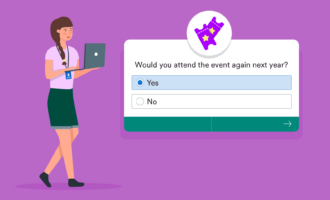A successful event is a careful balance of business and downtime, focus and entertainment, meeting new contacts and reconnecting with old friends. Memorable business events seamlessly move through all of those phases, but what’s rarely apparent to participants is how much planning and work goes into making the gathering a success.
Event planning is one the most stressful jobs in the U.S., but it’s a good deal less stressful if you work with a thorough event planning checklist.
While no two events are exactly alike, the work of planning an event — whether organizing a massive trade show that gathers an entire industry or building and staffing a standout booth at a show — has enough similarities that this event planning checklist can help.
1. Establish your goals
The broad intent of your business event — and every business event — is to gather people of common interests so they can network, build trust, and do business with each other. Drill down from those general goals to get clear on exactly what you’re trying to accomplish.
- Articulate the overarching goal of your event. Is it to attract a business crowd for networking, or is it to create a harvest fair designed to give local businesses an annual boost while promoting an important local product? How will you measure success?
- Decide on a date. When will the event take place? Are you trying to establish this as an annual event?
- Consider your venue options. What venues in the region fit the criteria for size, resources, and price?
- Establish what size crowd you’re trying to attract. Are there enough ancillary facilities — such as hotels, restaurants, and transportation — to accommodate them?
- Set your marketing and branding strategy before you announce the name and date of the event.
- Put together your core team and review with them your vision for the event and its purpose. Map out the role of each person and establish a timeline of goals.
- Determine the budget for the event. Do you need to find additional funds?
- Decide whether you’ll sell tickets to the event. If so, what’s the anticipated ticket price?
- Determine early in the process the cost of admission — even if it’s free — and the cost of booth space for business displays.
2. Think through the structure and pace of your program
You’ve stated the purpose of your event and inspired your team to embrace its importance. Now’s the time to carefully consider how to structure the event to achieve that purpose.
- Determine how long your event will last. Can you achieve your goal in a single session, such as a talk during a business breakfast before work? Or will the representatives and sales teams of industry leaders be coming to town for a few days to network and display their products?
- Consider how you can increase the number of opportunities for participants to learn and connect.
- Don’t overload attendees. Build in adequate breaks and provide quiet spaces where new contacts can chat.
- Carefully consider acoustics, lighting, site lines, and other factors when arranging the space.
- Attendees can be patient with a lot, but they won’t forgive you if the Wi-Fi is deficient. Ensure that there’s abundant bandwidth.
- Decide how you’ll measure the effectiveness and outcomes of your event.
3. Find the ideal venue
Renting the venue will probably be the biggest single expense of your event, but don’t skimp. The facility must be large enough so that everyone has sufficient room — but not so large that a good crowd seems smaller than it really is.
- Determine where you anticipate event participants will come from to decide which city will host the event. Start searching for venues in that location.
- List every venue that meets your minimum requirements and work down from that to a shortlist that has the best amenities for the most competitive price.
- Tour facilities with your team and event sponsors.
- Once you’ve decided on the best available venue, negotiate a contract on terms that reflect the value you’re bringing (see no. 4, below).
- Map out the event and allocate space.
- Task your logistics team with getting to know the venue thoroughly enough to ensure the smooth flow of people and equipment when the building is jammed with your attendees.
- Make certain the Wi-Fi has ample bandwidth to accommodate every user.
4. Vet vendors
Events are powerful economic engines. Keep that in mind when you’re negotiating with vendors.
- Once you’ve chosen the city or region for the event, shop the available venues. If you expect a big crowd, you’ll have negotiating leverage.
- Don’t take the “sticker price” of the venue at face value. Are there extra charges for parking, insurance, security, or any other necessities?
- Decide whether or not to provide food for attendees. If the answer is yes, does this entail a catered meal or leasing space to food carts?
- Determine if offering discount tickets — such as for early purchase — makes sense.
- If your event will require overnight stays, work out deals with nearby hotels. You don’t want to lose any potential attendees because they started looking for a room too late.
- Be prepared to announce your keynote speaker, entertainers, influencers, or celebrity guests when you announce your event. Make sure all contracts are finalized and be certain your venue can accommodate any specific technical requirements.
5. Develop a registration process, even if you aren’t charging admission
Events typically charge admission, but even those that don’t use a registration process to make sure there’s no overcrowding and to keep tabs on who is there.
- Select registration software that meets your requirements, and train your registration team to use it.
- Set up an online registration process to accommodate attendees who are coming from far away.
- Revisit the ticket price, if you’re charging admission, and create a ticket sales process.
- Determine your refund policy.
- Revisit whether you will give any discounts. Can you afford to offer discounts for early registration or large groups? That’s an important early decision.
- Have a no-charge admissions policy for registered media.
6. Focus on sponsors
Finding sponsors is often the biggest challenge event organizers face. Don’t doubt yourself if it’s tough because it’s not easy for anybody.
- Event sponsorships are subject to trends just like anything else, so research what interests sponsors and be prepared to go with that.
- Carefully think through which potential sponsors are most aligned with the goals of the event.
- Research your potential sponsors, their goals, and their place in the market to prepare for pitching them.
- List the benefits of sponsorship and be ready to defend those if the potential sponsors are at all skeptical.
- Draft proposals for each targeted potential sponsor. Prepare to offer different levels of sponsorship. Some companies will only have the budget to hang a banner or sponsor a panel, so have a price in mind for all budgets.
- Enlist the help of the travel-and-tourism staff of the local chamber of commerce in your search for sponsors.
7. Plan and implement PR and marketing
No item on your event planning checklist is worth bothering to accomplish if you can’t get people to attend the event. Spreading the word about the event to those most likely to find value in it is a priority.
- Gather data to clarify your target demographic and determine the best media to reach them.
- Events have become a significant item in corporate marketing budgets, so be prepared to thoroughly demonstrate the return on investment (ROI) a person or organization might realize from participating in your event.
- Establish key performance indicators (KPIs), such as building a dedicated website by a certain date, sending weekly press releases, and gathering an email marketing list.
- Map out separate but compatible marketing strategies for event sponsors and corporate display booth rentals on the one hand and ticket-purchasing attendees on the other. Keep in mind that your success with one will drive your success with the other.
- Social media is an important part of event marketing, so make sure your team has expertise in the strategic use of Facebook ads and similarly effective social media tools.
- Invite bloggers and trade journalists to the event and keep them up to date with regular press communications.
8. Ensure the safety of the event
The number of attendees at the largest events — such as the annual Consumer Electronics Show (CES) in Las Vegas — equals the number of people living in many small cities, but they’re in a much smaller space. This puts tremendous responsibility on event planners — to say nothing of legal liability. Carefully prepare for potential emergencies and think through how to reduce foreseeable risks.
- Make absolutely certain you have all required permits and that your venue is in complete compliance with all local and state fire and safety codes.
- Familiarize your security team with emergency exits and evacuation procedures in the event that becomes necessary.
- Review all vendor applications for necessary insurance and health and safety permits. Remember that as the event organizer at least some liability for vendor shortcomings will fall on you.
- Plan how paramedics would reach someone during a medical emergency and how they would evacuate the person from a crowded venue.
- Have someone on your team who is trained in risk assessment review your venue for potential dangers, such as trip hazards or unsafe electrical connections. The best way to handle an emergency is to avoid it.
As this lengthy event planning checklist makes clear, you have to keep many balls in the air for an event to succeed. Event planning is a team exercise and one of the great management challenges in the business world. The key to success is planning and organization. Adapt this checklist to the particulars of your event, and you’ll be on your way.




































































Send Comment: